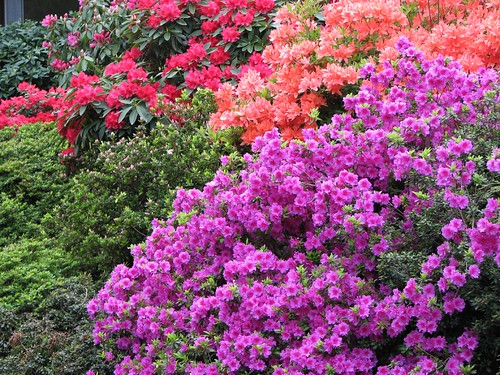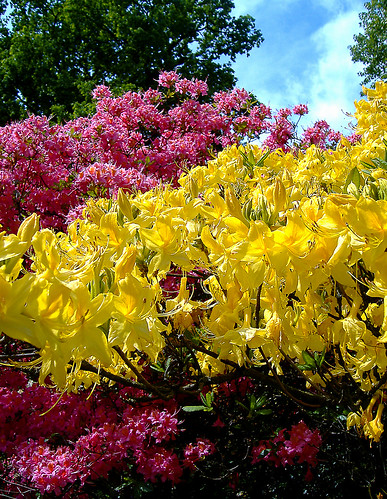 Azaleas & Rhododendrons by Stones 55
Azaleas & Rhododendrons by Stones 55
Spring is a great time to plant azaleas and rhododendron. If you can’t plant them in the spring, early Fall planting is also recommended.
When you buy rhododendrons or azaleas, make sure you give them a good drink. They can remain in the pot or burlap for a long time if you give them a drink every couple of days or as the need exists.
RHODODENDRON BUSHES by m.m b
Choose the site carefully.
“Rhododendrons and azaleas are healthiest in light shade, especially under oaks and pines with the lower branches trimmed up. Do not choose a location near maples, elms, ashes or other trees with shallow competitive root systems. Some varieties of azaleas and rhododendrons may survive in full sun, but avoid planting them in a south, southwest or west exposure, especially if heat and light are reflected on the plants from a nearby building. In dense shade the plants tend to grow spindly and do not bloom profusely. Protection from winter’s cold drying winds is also desirable.
Planting soil should be acid with pH between 4.0 and 6.0. Avoid areas with old builder’s debris, particularly mortar which can raise the soil pH above the desirable range. Rhododendrons and azaleas require a well drained soil, free of any standing water. Do not plant rhododendrons under down spouts or at the edges of sidewalks and driveways because poor drainage, lime or salts may kill them. Do not plant in places where other rhododendrons have wilted and died because the site may still be contaminated with disease organisms. ” See here.
If you are planting a balled and burlapped plant, remove the wrappings. They used to say that you can leave the burlap on the root when planting, because the burlap will rot. But to really give your plant a good start, remove any wrappings, especially plastic or wiring. If you buy container-grown plants be sure to make several vertical slits about 1/2 ” deep cuts from top to bottom, evenly spaced around the root mass. This encourages new root growth.
azaleas and rhododendrons by pixelviz
Azaleas and rhododendrons cannot survive in just “good topsoil.” The soil, whether it is clay, sand or “good topsoil.” should have 60% garden compost or composted leaf mulch or peat moss mixed into 40% soil. This ensures that the root system can move easily into the soil. Compost also will help the soil retain moisture and provide aeration for the roots. Watering should be done just to keep the soil moist- both overwatering and insufficient water will kill your plants. (This soil mixture is a good mixture for many other shrubs).
The planting hole size should be at LEAST 6 inches all the way around. The larger the diameter, the better.
The depth of the hole is crucial. Dig the planting hole NO Deeper than the root ball of the specimen to be planted because both azaleas and rhododendron roots don’t go deeper than 12-16 inches, even for a mature plant. One of the main reasons a rhododendron or azalea dies is because it was planted too deep and the root system smothered. So forget the old rule of digging a hole twice as deep as the root ball! Save yourself work. See here. When planting fill the hole with the 60/40 soil mix. Put the plant on top of the soil mix and fill in around the plant. Leave 10% of the root height ABOVE ground level and cover top of root system with more of the soil mix. (As the soil mix settles, the plant will settle into the ground but won’t go below ground level. ) On the top of the soil mix put a mulch of things like pine bark, wood chips. DON’T use peat moss as a mulch.
Do NOT mix fertilizer into the soil mix. Apply fertilizer right AFTER blooming. Always sow fertilizer on top of the soil. Use the proper rates which is 1-2 handfuls for a 12-18 inch plant (more for a larger plant and less for a smaller.) The best fertilizer for the Delaware Valley area should say 10-6-4 on the bag. Liquid fertilizer is excellent provided you make sure the ground is wet before applying because it will run off dry soil and the roots won’t absorb any.
According to the American Rhododendron Society, young azaleas and rhododendrons need to be pruned frequently so that you stimulate root development and the top growth doesn’t exceed root system growth and will encourage the plant to be bushy, not leggy. Pruning should be done after BLOOMING. Prune no later than early July for rhododendrons and not later than mid July for azaleas . If you cut later, you will not get flowers next year. Of course, you should always prune dead or damaged branches any time. When pruning Azaleas, take at least 1 inch off last year’s growth. As Rhododendrons age they need very little pruning unless they become leggy. If your rhododendrons are leggy, prune back to a node, which is where the growth originated.
Most of this information comes from The American Rhododendron Society. Consider becoming a member to get answers to your questions and to learn the most current information about azaleas and rhododendron.


